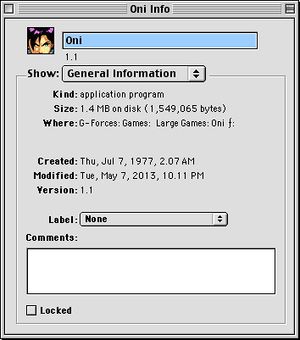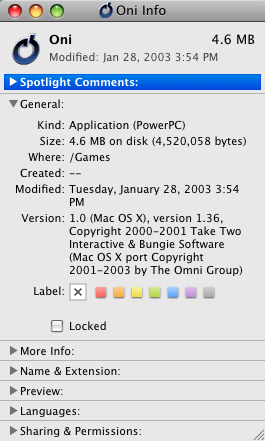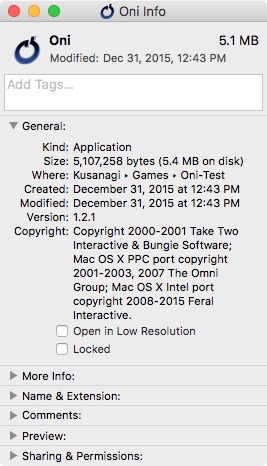History of Mac Oni: Difference between revisions
m (→Carbon to Cocoa: clarifying that patches were being done with hex edits) |
m (→PPC to Intel: wording) |
||
| Line 22: | Line 22: | ||
==PPC to Intel== | ==PPC to Intel== | ||
[[Image:Feral_Oni_Get_Info_window.jpg|thumb|Feral's Intel port of Oni for Mac OS X.]] | [[Image:Feral_Oni_Get_Info_window.jpg|thumb|Feral's Intel port of Oni for Mac OS X.]] | ||
In 2006 Apple began their '''third''' major Mac transition: the [[wikipedia:Apple's_transition_to_Intel_processors|switch to Intel processors]], back to CISC architecture and moving away from the PowerPC chip for which both Bungie and The Omni Group had built Oni. For a while, PPC apps could be run on Intel Macs using [[wikipedia:Rosetta_(software)|Rosetta]], but support for the old architecture was expected to eventually phase out. In 2009, [http://www.feralinteractive.com/en/ Feral Interactive] (Oni's Mac distributor outside of North America) [http://oni.bungie.org/community/forum/viewtopic.php?id=848 expressed an interest] in putting out an Intel-native build of Oni. They obtained the source code from The Omni Group | In 2006 Apple began their '''third''' major Mac transition: the [[wikipedia:Apple's_transition_to_Intel_processors|switch to Intel processors]], back to CISC architecture and moving away from the PowerPC chip for which both Bungie and The Omni Group had built Oni. For a while, PPC apps could be run on Intel Macs using [[wikipedia:Rosetta_(software)|Rosetta]], but support for the old architecture was expected to eventually phase out. In 2009, [http://www.feralinteractive.com/en/ Feral Interactive] (Oni's Mac distributor outside of North America) [http://oni.bungie.org/community/forum/viewtopic.php?id=848 expressed an interest] in putting out an Intel-native build of Oni. They obtained the latest version of Oni's source code from The Omni Group (who had already begun porting it to Intel), and made their initial public release of Oni for Intel Macs in the spring of 2011, a few months before the first version of OS X without Rosetta was released. The Feral build of Oni incorporates a number of changes requested by fans, detailed [[AE:FERAL|HERE]]. | ||
</div> | </div> | ||
[[Category:Oni history]] | [[Category:Oni history]] | ||
Revision as of 14:02, 25 July 2015
- For the overall history of Oni's development, see Oni.
Windows Oni 1.0 to Mac Oni 1.1
While Oni was developed by Bungie West simultaneously for Windows and Mac OS (with the PlayStation 2 port being done in parallel by Rockstar), the game's development was not completed for both PC platforms at the same time. Oni was gold mastered for Windows around mid-November 2000. The Mac version continued in development for at least another month, partly due to a graphics bug discovered at the last minute.
At some point after gold-mastering Windows retail Oni, while still working on Mac Oni, but before the Windows demo was made, some significant changes were made to the layout of the level data. See Windows Oni vs. Mac Oni for details. The Oni app for the Windows demo was built afterward, thus it has the same differences from retail Windows Oni as Mac Oni does.
As a result, Windows retail Oni is at version 1.0 (as seen in the Windows read-me), and the original game app for Macs was version number 1.1 (pictured, right; also see the Mac read-me). But even long after 1.1, the Mac Oni app would continue to evolve.
Classic to Carbon
As seasoned Mac users will recall, the Macintosh has been through three major technology transitions since 1984. First came the move from CISC-based 68k to RISC-based PowerPC processors in the early '90s. Thus, when Oni began development in 1997, all Macs ran on PPC processors. Apple was about to release Mac OS 8, but it was still based on System 1 from 1984, and they were hoping to start fresh with a new OS as soon as possible. To that end, Apple acquired Steve Jobs' company NeXT in order to use their OS, OPENSTEP, as the basis for Apple's new OS. The Mac's second major transition culminated with the release of Mac OS X in spring 2001 -- awkward timing for Oni.
In 2000, Bungie was merging into Microsoft, and Take-Two was assuming command of the Oni IP. Having been in development years before OS X released, Mac Oni would initially have been built as a "Classic" app, referring to the Classic Mac OS (anything before 10.0). Given the circumstances, the best that Bungie could do for compatibility before Oni released in January 2001 was to build the Oni application as a "Carbon" app. Carbon apps could be written primarily for OS 9 and still run on OS X. Unfortunately, the Carbon build of Oni was not without issues in the OS X environment.
Carbon to Cocoa
Then, at the end of 2001, The Omni Group released a "Cocoa" (native OS X) build of the game which they had produced for free. This became known as the Omni build (now usually referred to as the PPC build). Their new builds (released through 2003) kept Oni stable for several years. The last Omni build is still available here and here. However, as computers advanced, a critical bug appeared in both Windows and Mac Oni: the game would immediately crash while querying the graphics card at startup. Once a patch, made through hex editing, was figured out in Windows, it was carried over to the PPC build. Other patches were made in time to the PPC build; see HERE for details.
PPC to Intel
In 2006 Apple began their third major Mac transition: the switch to Intel processors, back to CISC architecture and moving away from the PowerPC chip for which both Bungie and The Omni Group had built Oni. For a while, PPC apps could be run on Intel Macs using Rosetta, but support for the old architecture was expected to eventually phase out. In 2009, Feral Interactive (Oni's Mac distributor outside of North America) expressed an interest in putting out an Intel-native build of Oni. They obtained the latest version of Oni's source code from The Omni Group (who had already begun porting it to Intel), and made their initial public release of Oni for Intel Macs in the spring of 2011, a few months before the first version of OS X without Rosetta was released. The Feral build of Oni incorporates a number of changes requested by fans, detailed HERE.


